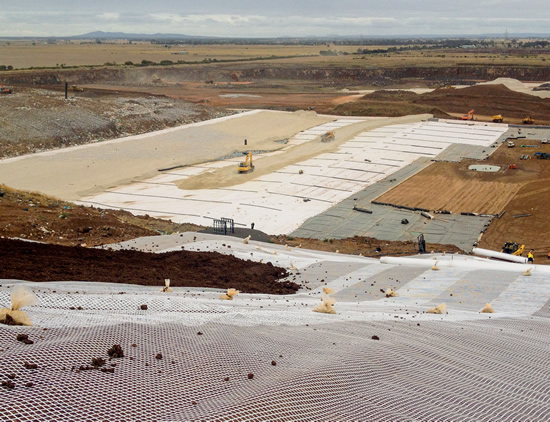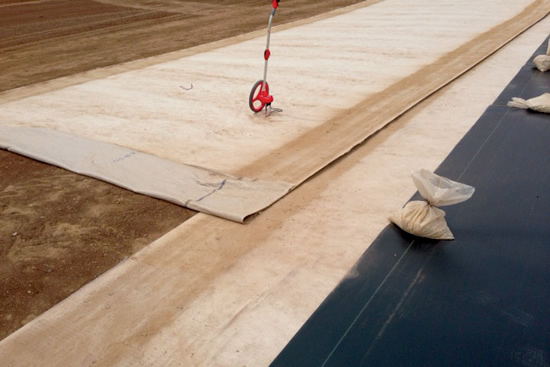
 By NAUE – An Australian quarry became of the country’s largest landfills, with the installation of a geosynthetic clay liner (GCL) barrier system. The site, known as the Western Landfill, has an available airspace totaling more than 15,000,000m3. Since 1999, the facility has offered municipal and commercial waste management services to metropolitan Melbourne. Today, more than 30% of Victoria’s putrescible waste is managed there.
By NAUE – An Australian quarry became of the country’s largest landfills, with the installation of a geosynthetic clay liner (GCL) barrier system. The site, known as the Western Landfill, has an available airspace totaling more than 15,000,000m3. Since 1999, the facility has offered municipal and commercial waste management services to metropolitan Melbourne. Today, more than 30% of Victoria’s putrescible waste is managed there.
The landfill also includes a substantial landfill gas (LFG) operation. The decomposing waste creates enough biogas to power 4,000 homes. An on-site plant converts the gas, which is generated in the waste piles and collected through an extensive network of pipes. Gas collection is further enhanced by the utilization of geosynthetic cover systems on closed cells.
The Western Landfill was previously operated by Boral but acquired by Transpacific Industries in late 2014. It operates in compliance with Victoria EPA regulations and Landfill Best Practice Environmental Management (BPEM) guidelines. These regulations are on par with the enhanced environmental protection standards used in many countries for waste management. Chiefly, these regulations are designed to protect groundwater supplies, such as from leachate and to do so, they require the use of geosynthetic lining systems.
The waste cells at the former quarry are managed largely in the same way as at more traditional landfill sites: the land is parceled into multiple cells, each with its environmental protections and monitoring; and, when a cell is filled, it is capped and new waste is subsequently diverted into the next open cell.
For the construction of the two recent cells, the operators followed their standard approach in a lining system (noted from bottom-up):
- Clay
- Geosynthetic clay liner (GCL)
- High-density polyethylene (HDPE) geomembrane
- Protection and drainage layers
NAUE Bentofix® GCLs were selected for the newest lining system.
HOW GCL TRANSFORMED AUSTRALIAN QUARRY
Bentofix® has been used as a base liner or barrier system component for landfills and leachate ponds around the world. It has also been used routinely for cover systems when waste cells are closed. The GCL is a composite product that features robust geotextile layers on top and bottom and a central core of high-swelling, powdered sodium bentonite. The needlepunched nonwoven geotextiles provide excellent frictional characteristics and long-term durability, as well as the flexibility to accommodate normal waste settlement variances, so Bentofix® is appropriate for flat, sloped, or curved soil and cell geometries. The bentonite core provides an exceptional barrier to liquid. It swells in contact with water and, subsequently, becomes too dense for other liquid to flow through.
Importantly, Bentofix® GCLs enable a higher level of environmental protection than just compacted clay, which is why modern landfill barrier designs use significantly less traditional clay, opting instead for thinner, more efficient, more economical and more durable GCL layers.
All of these reasons made Bentofix® an attractive option for the Western Landfill.
In total, 160,000m2 of Bentofix® GCLs were installed by Australia-based Global Synthetics. Their work has helped secure the future of Melbourne’s waste management system and groundwater.
The Western Landfill continues to evolve, having been a quarry, an asphalt plant, and now a landfill and renewable energy producer. It does so with state-of-the-art environmental controls, including geosynthetics.
Learn more about NAUE’s geosynthetics, projects, and engineering services at www.naue.com.
NOTES
Additional stories about this site have previously appeared in NAUE News #43 (PDF) and in Global Synthetics’ Geonews #8 (PDF). Arcadis, which provided consulting services to Transpacific Industries prior to its acquisition of the Western Landfill, has also written about the site.
Bentofix® GCLs are also listed at GeosIndex.com, an online, open source for reviewing geosynthetic data.
See also











